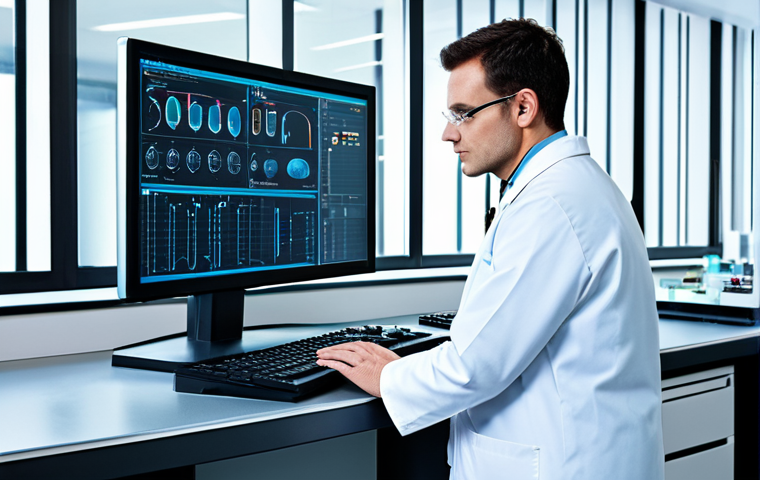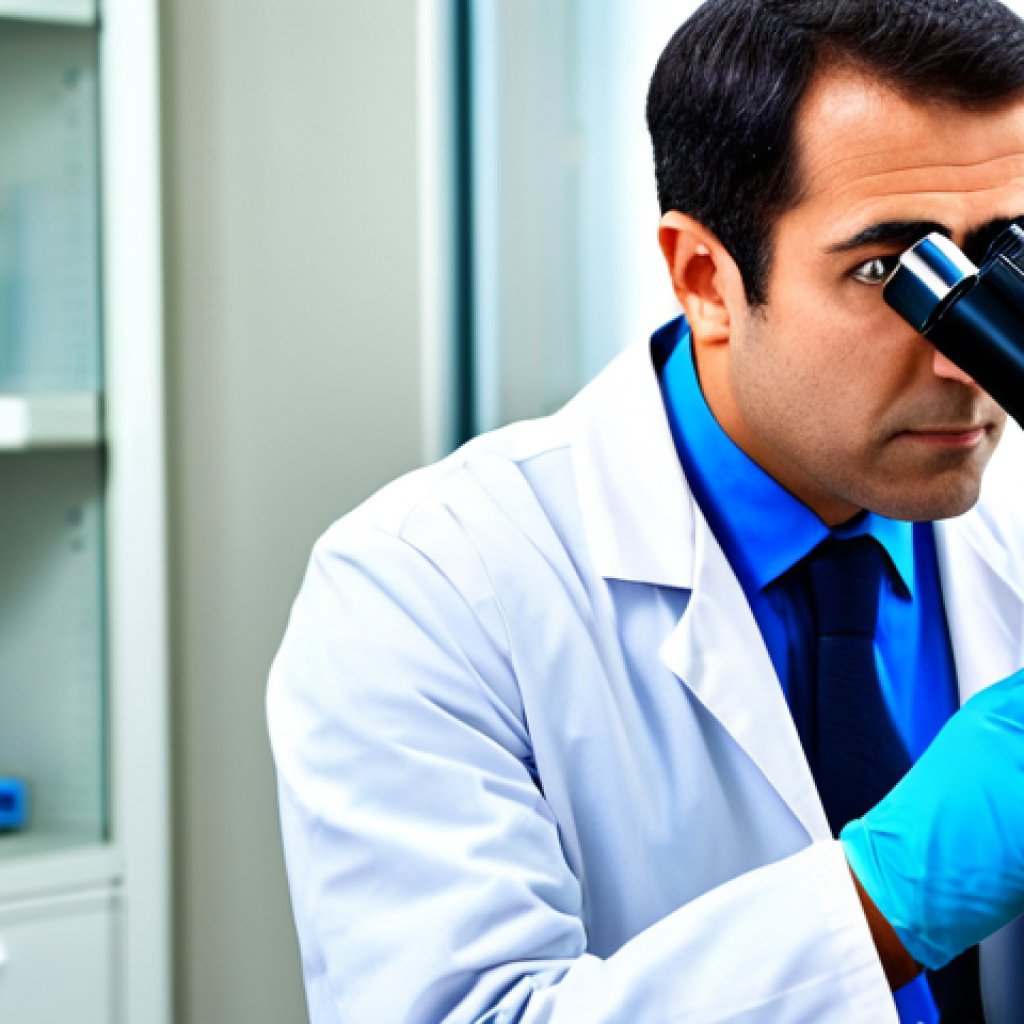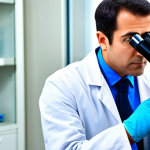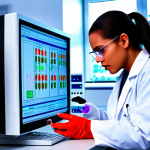Waking up before dawn, the city still slumbering, I often reflect on the unique rhythm of a Medical Laboratory Scientist’s day. It’s not your typical 9-to-5, nor is it a quiet, sterile environment like many might imagine.
From the moment I walk through those lab doors, it’s a vibrant, often intense, whirlwind of activity – a true backstage pass to the world of diagnostics.
I’ve seen firsthand how every single tube, every tiny sample, holds a critical piece of a patient’s health puzzle, demanding unwavering focus and an almost intuitive understanding of intricate biological processes.
In an era where precision medicine and rapid disease identification are paramount, our role has never been more pivotal, seamlessly linking cutting-edge technology with real-time patient care.
It’s a job where you constantly learn, adapt, and make tangible contributions to well-being, feeling that palpable connection to saving lives, even when unseen.
Let’s delve deeper in the article below.
The Unseen Architects of Healthcare: My Daily Immersion

Stepping into the lab each morning, there’s an immediate shift in my entire being. The quiet hum of analyzers, the crisp scent of reagents, and the focused energy of my colleagues create an atmosphere unlike any other. It’s a space where every test result, every slide examined, directly impacts a patient’s journey – often without them ever knowing the diligent hands behind the curtain. From the rapid identification of sepsis pathogens to the intricate analysis of cancer markers, we are the silent sentinels, armed with microscopes and highly specialized instruments, translating complex biological signals into actionable medical insights. It’s a deep responsibility, one that I feel profoundly with every shift, knowing that my precision and critical thinking contribute directly to diagnostic accuracy and, ultimately, patient well-being. This isn’t just a job; it’s a constant, invigorating challenge to unlock the body’s hidden stories.
1. The Morning Rush: Orchestrating the Diagnostic Symphony
My shift often begins with a deluge of samples from the emergency room and various hospital units. Tubes of blood, urine, and other bodily fluids arrive, each representing a person awaiting answers. My first task is always to prioritize: stat (urgent) samples get immediate attention, their bright red caps a visual cue for urgency. I remember one frantic morning when a young patient’s blood sample arrived, flagged for suspected diabetic ketoacidosis. The rapid turnaround of that glucose and electrolyte panel allowed the medical team to intervene swiftly, potentially preventing a life-threatening complication. It’s a race against time, but a controlled one, where every step – from sample accessioning to instrument loading – must be executed with flawless precision. There’s a subtle choreography to it, a rhythm only perfected through countless hours and a deep understanding of laboratory operations.
2. Navigating the Lab’s Complex Eco
The sheer variety of tests we perform daily is astounding. One moment I might be cross-matching blood for a transfusion, the next I’m culturing bacteria from a wound infection, or even analyzing cerebrospinal fluid for signs of meningitis. Each test has its own unique protocol, its own set of quality control checks, and its own potential pitfalls. It’s this constant intellectual engagement that keeps me on my toes. I’ve encountered countless unusual cases, from rare genetic disorders surfacing in routine blood work to obscure parasitic infections, each demanding a nuanced approach and often, collaborative problem-solving with my colleagues. The lab is a living, breathing entity, with different departments – hematology, chemistry, microbiology, blood bank – all working in concert, each providing a vital piece of the diagnostic puzzle.
Beyond the Microscope: Decoding Disease Stories
While the image of a scientist peering into a microscope is iconic, our work extends far beyond that. It’s about detective work, combining cutting-edge technology with keen observation and a comprehensive understanding of human physiology and pathology. Every abnormal result isn’t just a number; it’s a clue, a potential red flag signaling a deeper issue. My role involves not just running tests, but interpreting the data in context, recognizing patterns, and often communicating critical findings to physicians who then make life-altering decisions based on our insights. It’s a fascinating blend of the scientific and the human, transforming raw data into a narrative that helps save lives.
1. The Art of Interpretation: Connecting the Dots
Running a sample through an analyzer is only half the battle. The true expertise lies in interpreting the results. Is this elevated enzyme level due to a heart attack, or could it be something else entirely? Does this atypical cell morphology indicate a benign condition or a serious malignancy? This is where years of training, continuous education, and hands-on experience truly come into play. I recall a time when a patient’s kidney function tests showed a subtle but consistent decline over several days. While no single result was alarmingly out of range, the trend indicated a developing issue that I flagged to the medical team, leading to early intervention that prevented further damage. This proactive identification of trends, rather than just isolated values, is a hallmark of an experienced MLS.
2. Quality Control: The Unsung Hero of Lab Accuracy
Before any patient sample is run, we perform rigorous quality control (QC) checks. These are essentially “tests for our tests,” ensuring that our instruments are calibrated correctly, reagents are performing as expected, and our results will be accurate and reliable. Imagine performing a blood glucose test on a patient, only to find out later that the machine was miscalibrated. The implications could be catastrophic. My mornings often involve running multiple levels of controls for each instrument, meticulously plotting data, and troubleshooting any deviations. It’s a meticulous, often repetitive process, but it’s the bedrock of our reliability, something I take immense pride in. The trust placed in our results by clinicians hinges entirely on our unwavering commitment to quality. The continuous pursuit of perfection in this area truly underpins the entire diagnostic process.
A Symphony of Precision: Technology and Human Expertise
The modern medical laboratory is a marvel of technological advancement. Robotic arms pipette samples, high-throughput analyzers process thousands of tests per hour, and intricate software algorithms help us manage vast amounts of data. Yet, amidst all this automation, the human element remains irreplaceable. Our expertise lies not just in operating these machines, but in understanding their nuances, troubleshooting when they err, and most importantly, in applying critical judgment that no algorithm can replicate. It’s a dance between human intellect and machine precision, where each complements the other to achieve diagnostic excellence.
1. Mastering the Machines: From Setup to Troubleshooting
Every piece of equipment in the lab, from the simplest centrifuge to the most complex molecular diagnostic platform, requires a deep understanding to operate effectively. We aren’t just pushing buttons; we’re performing daily maintenance, running calibration curves, and troubleshooting error codes that can range from a simple clog to a complex sensor malfunction. I’ve spent countless hours with instrument manuals, learning the intricacies of flow cytometers, automated chemistry analyzers, and mass spectrometers. There’s a particular satisfaction in diagnosing and fixing an instrument issue, knowing that I’ve restored its ability to provide accurate results for patients waiting for their diagnoses. It’s a testament to the blend of scientific knowledge and practical, hands-on engineering skills required in our field.
2. The Irreplaceable Human Eye: Microscopic Mastery
Despite incredible advancements in automated cell counters, the human eye remains paramount, especially in hematology and microbiology. Automated differentials can flag abnormal cells, but it’s my experienced eye that confirms a blast cell, identifies a parasitic inclusion, or differentiates between various types of bacteria. There’s a subtlety to cell morphology, a nuance in bacterial growth patterns, that only years of direct observation and training can truly discern. I vividly remember catching a rare type of leukemia during a routine blood smear review that had been missed by initial automated flags. That moment solidified for me that while technology amplifies our capabilities, the human expert remains the ultimate arbiter, especially in complex or unusual cases. This discerning eye, honed over time, is a critical component of our comprehensive diagnostic capabilities.
The Adrenaline Rush: Navigating High-Stakes Moments
While much of our work demands methodical precision, there are moments when the lab transforms into a high-octane environment. Critical values, emergency transfusions, and urgent pathogen identifications demand immediate, decisive action. These are the moments when the weight of our profession becomes acutely palpable, when seconds can genuinely mean the difference between life and death. The ability to remain calm under pressure, to think critically, and to execute flawlessly when the stakes are highest is a defining characteristic of a skilled Medical Laboratory Scientist.
1. STAT! When Every Second Counts
The word “STAT” echoes frequently through our labs, signaling an immediate need for results. This isn’t just about speed; it’s about maintaining accuracy at an accelerated pace. A patient in the ER with chest pain needs troponin levels now. A trauma patient losing blood needs compatible units for transfusion immediately. I’ve often felt my heart rate quicken in these moments, but my training kicks in, guiding my hands through the rapid processing, analysis, and validation. There was a particularly memorable night shift where we received multiple trauma patients simultaneously. The blood bank became a flurry of activity, and the seamless coordination between us and the clinical team was vital in getting life-saving blood to patients within minutes. It’s an intense, yet incredibly rewarding, aspect of the job.
2. Communicating Critical Results: The Lifeline to Care
Obtaining a critical result is only half the battle; ensuring it reaches the right clinician promptly is equally crucial. A “critical value” is a result so abnormal it indicates an immediate threat to a patient’s life and requires immediate action. My responsibility is to verify the result, re-run if necessary, and then personally call the ordering physician or nurse, ensuring they receive the information clearly and promptly. This direct communication pathway is a lifeline, facilitating rapid clinical decisions. I’ve had many conversations where my voice, conveying a critical potassium level or a dangerously low hemoglobin, became the catalyst for a rapid medical response, demonstrating that our role extends beyond just the bench; it reaches directly into patient care. This direct contact with the medical team further solidifies the impact of our behind-the-scenes work.
Continuous Evolution: Lifelong Learning in the Lab
The landscape of medicine and laboratory science is in perpetual motion. New diseases emerge, diagnostic technologies advance at breakneck speed, and understanding of biological processes deepens with every passing year. For a Medical Laboratory Scientist, this means lifelong learning isn’t just a recommendation; it’s an absolute necessity. The moment you stop learning, you risk becoming obsolete. I’ve personally invested countless hours in professional development, attending workshops, reading scientific journals, and even pursuing advanced certifications, all to ensure I remain at the forefront of diagnostic excellence. It’s a field that constantly challenges you to grow, adapt, and refine your expertise.
1. Staying Ahead: Adapting to New Technologies
The pace of technological innovation in the lab is breathtaking. From fully automated molecular platforms that can detect multiple pathogens simultaneously to sophisticated mass spectrometry techniques for drug monitoring, the tools we use are constantly evolving. I remember the significant learning curve when our lab adopted a new generation of hematology analyzers with vastly expanded capabilities. It required dedicated training sessions, hands-on practice, and a commitment to understanding the new principles behind the technology. Embracing these advancements isn’t just about efficiency; it’s about providing more accurate, comprehensive, and timely diagnoses to patients. The thrill of mastering a new piece of equipment and seeing its benefits unfold is a constant motivator.
2. The Ever-Changing World of Disease and Diagnostics
Consider the recent global health challenges; our labs were on the front lines, rapidly developing and validating new tests for novel pathogens. This dynamic environment means that our knowledge base must constantly expand. I regularly engage with scientific literature, attend webinars, and participate in continuing education programs to stay updated on emerging infectious diseases, new cancer markers, and advancements in genetic testing. This isn’t just about accumulating facts; it’s about understanding the underlying scientific principles that allow us to adapt our methodologies and interpret results in light of new knowledge. This intellectual curiosity is fundamental to thriving in such a fast-paced and impactful field.
The Emotional Undercurrent: Connecting Science to Humanity
Despite the highly technical nature of our work, the human element is always present. Every sample represents a person, a family, a story. While we may not directly interact with patients as frequently as nurses or doctors, the impact of our work is deeply personal and profoundly meaningful. There are moments of immense satisfaction when our precise results lead to a positive outcome for a patient, and there are also moments of quiet reflection when a diagnosis is grim. It’s this profound connection to human well-being that fuels my dedication and reinforces the immense value of what we do every single day.
1. The Weight of Diagnosis: Responsibility and Empathy
It’s impossible to remain completely detached when handling samples that will determine a life-altering diagnosis. While we maintain professional objectivity, an underlying empathy is always present. I often think of the person behind the tube – their anxieties, their hopes. When I’m validating a cancer diagnosis or identifying a life-threatening infection, the weight of that information is palpable. It reinforces the absolute necessity of precision and diligence in every single step. Knowing that my work provides clarity and direction for a patient’s treatment plan is a powerful motivator. This quiet empathy, this understanding of the human stakes, defines the unseen strength of a Medical Laboratory Scientist.
2. Celebrating Successes: The Unsung Victories
While our work is often behind the scenes, there are moments of immense pride and satisfaction. Hearing that a patient improved significantly after a critical diagnosis we helped make, or that a timely blood transfusion saved a life – these are the unsung victories that fuel our passion. We rarely receive direct thanks, but the knowledge that we are an indispensable link in the chain of patient care is incredibly rewarding. My most cherished memories involve those rare instances where a physician specifically thanks the lab for a rapid or accurate diagnosis that made all the difference. These moments, though few, underscore the vital and often overlooked impact we have on human lives. It’s a profound validation of our purpose and expertise.
| Laboratory Department | Primary Function / Common Tests | Impact on Patient Care |
|---|---|---|
| Hematology | Complete Blood Count (CBC), Coagulation Tests, Blood Smear Reviews | Diagnoses anemia, leukemia, clotting disorders; essential for monitoring blood-thinning medication. |
| Clinical Chemistry | Electrolytes, Glucose, Kidney/Liver Function Tests, Cardiac Markers | Assesses organ function, identifies metabolic imbalances, diagnoses heart attacks, monitors diabetes. |
| Microbiology | Bacterial Cultures, Gram Stains, Susceptibility Testing | Identifies infectious agents (bacteria, fungi, viruses) and determines effective antibiotics, guiding treatment for infections. |
| Blood Bank (Transfusion Services) | Blood Typing, Crossmatching, Antibody Screens | Ensures safe and compatible blood transfusions for surgery, trauma, and chronic conditions. |
| Urinalysis | Urine Chemical Analysis, Microscopic Examination | Detects urinary tract infections, kidney disease, diabetes, and other metabolic disorders. |
Wrapping Up
As I clock out each day, the quiet satisfaction of knowing our precision truly matters washes over me. We are the unsung heroes, diligently working behind the scenes, translating complex biological data into insights that guide critical medical decisions. This field is a fascinating blend of cutting-edge technology, scientific rigor, and an unwavering commitment to patient well-being. It’s a continuous challenge, an exhilarating pursuit of discovery, and a profound privilege to be an indispensable part of the healthcare journey, ensuring that every diagnosis is built on a foundation of accuracy and trust.
Useful Insights for Aspiring MLS Professionals
Thinking of a career in this vital field? A Bachelor’s degree in Medical Laboratory Science (MLS) or a related scientific discipline, often followed by professional certification (like ASCP in the US), is typically the starting point for this rewarding path.
The work environment for an MLS professional is incredibly diverse, ranging from the high-paced atmosphere of hospital labs serving emergency rooms and operating theaters, to specialized reference laboratories, public health agencies, or even research and development settings.
Attention to detail isn’t just a desirable trait; it’s absolutely non-negotiable. Every pipetting step, every quality control check, every slide examination demands meticulousness – your accuracy can literally determine the course of a patient’s treatment.
Continuous learning is ingrained in the profession. The landscape of diagnostics is always evolving with new technologies and emerging diseases, meaning MLS professionals are constantly engaging in professional development, workshops, and advanced certifications to stay at the forefront.
While often behind the scenes, your work has a direct, profound impact on patient lives. Your accurate and timely results empower doctors to make critical decisions, leading to earlier diagnoses, more effective treatments, and ultimately, better patient outcomes.
Key Takeaways
The Medical Laboratory Scientist is a foundational and indispensable professional in modern healthcare, seamlessly blending cutting-edge technology with irreplaceable human expertise. Our role demands rigorous precision, continuous learning, and a profound underlying empathy for every patient, making us crucial to accurate diagnosis and effective treatment. We are the quiet backbone of medicine, ensuring that every therapeutic decision is informed by reliable, high-quality laboratory data.
Frequently Asked Questions (FAQ) 📖
Q: You mention it’s “not your typical 9-to-5.” What does the unique, vibrant rhythm of a Medical Laboratory Scientist’s day truly entail?
A: Oh, “not your typical 9-to-5” is an understatement! It’s less a fixed schedule and more a series of critical sprints and strategic pauses, dictated by patient need.
I’ve worked shifts that start when the moon is still high in the sky, and others that stretch well past sunset, especially if you’re in a hospital lab supporting an emergency room.
There’s this constant hum of activity, interrupted by sudden urgent requests – a “STAT” sample from a rapidly deteriorating patient, for instance, which instantly becomes your top priority, pushing everything else aside.
You’re often juggling dozens of samples, each with its own story, its own required tests, all needing to be processed with absolute precision and speed.
It’s a bit like being a conductor in a high-stakes orchestra, where every instrument, every test, has to play its part at exactly the right moment to ensure a harmonious outcome for the patient.
It keeps you on your toes, no two days are truly alike, and that’s a big part of what makes it so engaging.
Q: How does a Medical Laboratory Scientist, often working behind the scenes, genuinely contribute to saving lives or tangibly improve patient well-being?
A: That’s the profound, sometimes overlooked, part of our job, isn’t it? We might not hold a patient’s hand, but we hold their health in our hands, quite literally, through their samples.
Think of it this way: a doctor can only treat what they can diagnose. We are the ones providing that diagnosis, or confirming it. I remember one frantic night, a sample came in from a child with rapidly worsening symptoms.
My colleagues and I worked through the night, meticulously culturing and identifying a rare bacterial infection that, if left untreated even for a few more hours, could have been catastrophic.
Or the time I flagged an electrolyte imbalance so severe in a routine blood draw that the patient, who felt “a little tired,” was rushed to immediate intervention.
It’s those moments, knowing that my careful analysis, my unwavering focus on that tiny tube of blood or fluid, directly guided a physician to the right life-saving treatment, that connect you to the very core of healthcare.
We’re the unsung heroes of precision medicine, empowering clinicians to make timely, informed decisions that truly turn the tide for patients.
Q: Given the “cutting-edge technology” and the need to “constantly learn and adapt,” what kind of ongoing professional development or mindset is crucial for a Medical Laboratory Scientist?
A: The world of medical diagnostics is a perpetual motion machine, and if you’re not moving with it, you’re falling behind. It demands a relentless curiosity and a humble recognition that you’ll never know everything.
We’re talking about new pathogens emerging, new genetic markers being discovered, and lab instruments evolving at an incredible pace – sometimes it feels like every few months there’s a new piece of tech that completely changes how we approach a test.
So, a crucial mindset is one of continuous learning. I spend a significant amount of time reading scientific journals, attending virtual conferences, and participating in workshops to stay abreast of the latest testing methodologies and disease trends.
Beyond the technical skills, it’s about cultivating an almost obsessive attention to detail and a profound sense of responsibility, because a single error, even a tiny one, can have monumental consequences.
It’s a career that forces you to be sharp, to be adaptable, and to genuinely love the process of discovery, because every day brings a new puzzle to solve, a new piece of the human health story to uncover.
📚 References
Wikipedia Encyclopedia
구글 검색 결과
구글 검색 결과
구글 검색 결과
구글 검색 결과
구글 검색 결과


